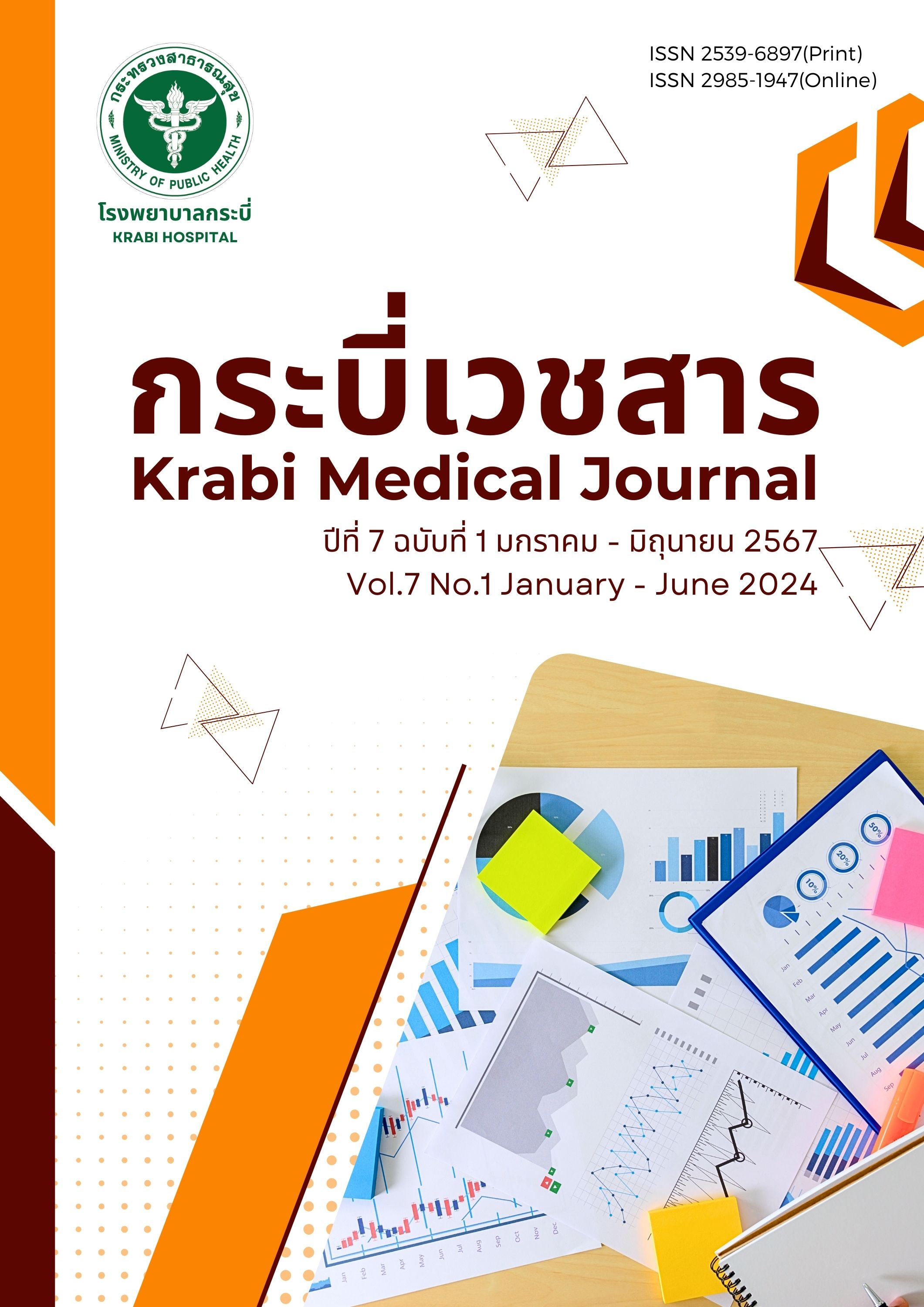The results of Therapeutic Apheresis treatment on patients with hematological diseases who received treatment at Krabi Hospital during the period of 2016 to 2023
Main Article Content
Abstract
Therapeutic Apheresis is a treatment for patients by separating components in the blood, such as white blood cells, lymph, and substances in the lymph that cause disease, from the patient. Apheresis in the long term will help chronic patients reduce the dosage of immunosuppressive drugs. resistance, such as steroids Reduce the duration of inpatient treatment as well as resulting in patients living and working normally. This research design was Retrospective descriptive study aimed at studying the results of Therapeutic Apheresis treatment on patients with hematological diseases who received treatment at Krabi Hospital. The objectives were to examine the efficacy of treating patients by separating blood components and to study the side effects of this treatment method. The research period is December 2023 to March 2024. A specific random sample was drawn from patients diagnosed with TTP and AIHA disease. There were 9 cases treated as inpatients and received treatment using Therapeutic apheresis. Data were collected using patient records from medical records and analyzed using descriptive statistics, presenting numbers, percentages, means, and ranges.
The results found that Sample groups that received treatment with the method Therapeutic Plasma Exchange (TPE) 9 cases. 8 cases (88.89%) survived and were discharged, while 1 case (11.11%) passed away. Among the surviving patients, 1 case (11.11%) had TPE discontinued. Laboratory test results showed a decrease in lactate dehydrogenase (LDH) levels from an average of 1,688 U/L before TPE to 919 U/L after TPE, an increase in hematocrit (Hct) from an average of 20% before TPE to 21% after TPE, and an increase in platelet count from an average of 50,556 cell/mm3 before TPE to 95,778 cell/mm3 after TPE. Minor adverse effects were observed in 3 cases (33.33%) during TPE, including pruritus in 2 cases and tremors and pruritic rash in 1 case.
In conclusion, Therapeutic Apheresis treatment for patients with hematological diseases, specifically Thrombotic Thrombocytopenic Purpura (TTP) and Autoimmune Hemolytic Anemia (AIHA), showed efficacy in treating TTP and AIHA. Therefore, Therapeutic Plasma Exchange doctors and related medical personnel should be considered as a first-line therapy for TTP patients and should also be considered for AIHA patients. Additionally, to reduce complications, administration of 10% calcium gluconate to prevent hypocalcemia and the use of male donor fresh frozen plasma (FFP) to mitigate other adverse effects should be considered
Article Details

This work is licensed under a Creative Commons Attribution-NonCommercial-NoDerivatives 4.0 International License.
บทความนิพนธ์ต้นฉบับจะต้องผ่านการพิจารณาโดยผู้ทรงคุณวุฒิที่เชี่ยวชาญอย่างน้อย 2 ท่าน แบบผู้ทรงคุณวุฒิ และผู้แต่งไม่ทราบชื่อกันและกัน (double-blind review) และการตีพิมพ์บทความซ้ำต้องได้รับการอนุญาตจากกองบรรณาธิการเป็นลายลักษณ์อักษร
ลิขสิทธิ์
ห้ามนำข้อความทั้งหมดหรือบางส่วนไปพิมพ์ เว้นว่าได้รับอนุญาตจากโรงพยาบาลเป็นลายลักษณ์อักษร
ความรับผิดชอบ
เนื้อหาต้นฉบับที่ปรากฏในวารสารเป็นความรับผิดชอบของผู้เขียน ทั้งนี้ไม่รวมความผิดพลาดอันเกิดจากเทคนิคการพิมพ์
References
Schwartz J, Padmanabhan A, Aqui N, Balogun RA, ConnellySmith L, Delaney M, et al. Guidelines on the Use of Therapeutic Apheresis in Clinical Practice-Evidence-Based Approach from the Writing Committee of the American Society for Apheresis: The Seventh Special Issue. J Clin Apher. 2016;31:149-62.
Schwartz J, Padmanabhan A, Aqui N, et al. Guidelines on the Use of Therapeutic Apheresis in Clinical Practice-Evidence-Based Approach from the Writing Committee of the American Society for Apheresis: The Seventh Special Issue. J Clin Apher. 2016;31(3):149-62. doi:10.1002/jca.21470
สุรัชดา ชนโสภณ, ธนะวัฒน์ วงศ์ผัน, ภูษิต ประคองสาย, ธนวรรณ ปรีพูล, ศิริรัตน์ อนุตระกูลชัย, กุมารี พัชนี, และคณะ. การศึกษาประสิทธิผลและการประเมินความคุ้มค่าการรักษาด้วยเครื่องพลาสมาเฟเรซิส [อินเทอร์เน็ต]. 2563 [เข้าถึงเมื่อ 2567 พ.ค. 14]. เข้าถึงได้จาก: https://kb.hsri.or.th/dspace/handle/11228/5240?locale-attribute=th
ภาควิชาเวชศาสตร์ชันสูตร คณะแพทยศาสตร์ จุฬาลงกรณ์มหาวิทยาลัย. การรักษาผู้ป่วย ด้วยเทคนิค Apheresis [อินเทอร์เน็ต].2566 [เข้าถึงเมื่อ 2564 พ.ค. 10]. เข้าถึงได้จาก: https://labmed.md.chula.ac.th/2023/05/04/การรักษาผู้ป่วยด้วยเทคนิค Apheresis /
Mc Cullough J. Therapeutic apheresis. Transfusion Medicine. 2ndeds. Elsevier Churchill livingstone 2005;520-3.
Owen HG, Brecher ME. Management of the therapeuticapheresis patient. Apheresis : Principle and practice.Bethesda : AABB press 1997:228-9.
Rolf B, V Koukline, Uri U, Edvard N. Plasmapheresis in severe sepsis and septic shock: a prospective, randomised, controlled trial. Intensive Care Med, 2002;28:1434-9.
สมใจ สมบัตินิมิตสกุล, ศิริพร ณ ถลาง,ราศี คงรักษา, ภาวิณี คุปตวินทุ, จุฑาทิพย์ ฟองศรัณย์, รัชนี โอเจริญ และคณะ. ประสบการณ์การทำ Therapeutic Apheresis ของศูนย์บริการโลหิตแห่งชาติ สภากาชาดไทย. J Hematol Transfus Med. 2006;16(3):201–2.
Therapeutic Plasma Exchange: Complications and Management. American Journal of Kidney Diseases. 1994 Jun 1;23(6):817–27.
Anand Padmanabhan , Laura Connelly-Smith , Nicole Aqui , Rasheed A Balogun , Reinhard Klingel , Erin Meyer , et al. Guidelines on the Use of Therapeutic Apheresis in Clinical Practice – Evidence‐Based Approach from the Writing Committee of the American Society for Apheresis: The Eighth Special Issue. Padmanabhan - 2019 - Journal of Clinical Apheresis - Wiley Online Library [Internet]. 2019 [cited 2024 Mar 17]. Available from: https://onlinelibrary.wiley.com/doi/10.1002/jca.21705


